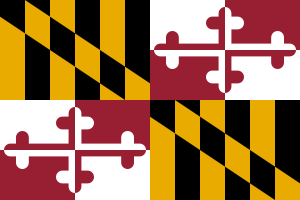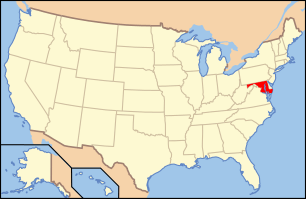Baltimore City Circuit Courthouses
| Clarence M. Mitchell, Jr., Courthouse | |
|---|---|
|
| |
| General information | |
| Architectural style | Greek Revival |
| Location | Downtown |
| Town or city | Baltimore City |
| Country | United States of America |
| Coordinates | 39°17′27″N 76°36′47″W / 39.2907°N 76.613°W |
| Construction started | 1896 |
| Completed | 1900 |
| Cost | $2.25 million |
| Client | Mayor and City Council of Baltimore |
| Technical details | |
| Size | 6 floors |
| Design and construction | |
| Architect | Wyatt and Nolting |
The Baltimore City Circuit Courthouses are state judicial facilities located in downtown Baltimore, Maryland. They face each other in the 100 block of North Calvert Street, between East Lexington Street on the north and East Fayette Street on the south across the Battle Monument Square, which held the original site of the first courthouse for Baltimore County and Town.
The first courthouse was built for new federal courts in the city. It was undercut in 1784 by Leonard Harbaugh with a pair of arched stone/brick arched piers to permit extension of Calvert Street to the north by passing underneath.[1] A second federal courthouse of Georgian and Federal style architecture in red brick and limestone trim with a cupola was constructed to the west of old Courthouse Square (later renamed Battle Monument Square in honor of the War of 1812). It was sited on the northwest corner of North Calvert and facing East Lexington Street, completed in 1805. This second Courthouse was partially burned on 13 February 1835 during a spate of arson fires in the city during the bank riots that year, but it was soon repaired. An adjacent masonry building to the west was constructed for a Records Office.[2]
A third courthouse, a federal district courthouse, was built 1896-1900, on the entire city block west of the Battle Monument. It is bounded by North Calvert Street on the east, East Lexington Street on the north, East Fayette Street on the south and St. Paul Street on the west.
The federal district courthouse was transferred to the state for its use after a new US Courthouse was constructed. Today the two historic main structures of the Maryland state judicial system in the City of Baltimore are the Clarence M. Mitchell, Jr. Courthouse and Courthouse East (the former Baltimore Post Office and U.S. Courthouse). Together they house the 30 judges of the 8th Judicial Circuit for the State of Maryland (Circuit Court of Maryland for Baltimore City). In addition to the criminal, civil and family (formerly orphans court) courts, these two courthouses also contain the Office of the State's Attorney for Baltimore City, the Clerk of the Circuit Court, the historic Baltimore City Bar Law Library, the City Sheriff's Office, the recently established Baltimore Courthouse and Law Museum (in the former Orphans Court chambers), the Pretrial Release Division of the Maryland Division of Corrections, several pretrial detention lockups, jury assembly rooms, land records, court medical offices and Masters hearing rooms.
History of area
What was the first federal courthouse in the city was constructed at what later became known as Battle Monument Square. Federal judges served on a circuit court basis, also holding court in other cities. The Battle Monument was designed by Maximilian Godefroy, (1765-c.1838), and built starting in 1815, on the first-year anniversary of the British attack on the city during the War of 1812. (It was completed in 1827, when sixth President John Quincy Adams, saluted the town as "The Monumental City.")
Clarence M. Mitchell, Jr. Courthouse
In 1894, 79 local and national architectural firms responded to a nationwide design competition under the Tarsney Act for the new federal district courthouse to be located at Baltimore City. This act required competition in the design of Federal buildings and was administered by the Office of the Supervising Architect of the U.S. Department of the Treasury.[3] Of the entries, a Beaux Arts–styled architecture of Roman and Greek Revival Courthouse was chosen that was proposed by the Baltimore firm of Wyatt and Nolting. The cornerstone for the Baltimore City Courthouse on the northeast corner facing Calvert and East Lexington Streets was laid in 1896; the building was dedicated at completion at a public ceremony on January 8, 1900.[4] Concerns that courtrooms were too austere resulted in the addition of murals executed between 1902 and 1910 by a number of artists, including the 1904 Burning of the 'Peggy Stewart' by Charles Yardley Turner (citizens of Annapolis had burned the ship in reaction to the "Tea Act" by the British Parliament in 1774, symbolizing rising resistance). A bronze statue of Cecilius Calvert (1605-1675), the second Lord Baltimore and First Proprietor of the Province of Maryland was erected in 1908 on the steps outside the west entrance, facing Saint Paul Street; it was sponsored by the Society of Colonial Wars in the State of Maryland. It is the site of annual "Maryland Day" (March 25) ceremonies which continue inside in the ceremonial chambers.
Because of changing court needs, a joint evaluation study of the structure was completed in 1946 by architect O.E. Adams and Henry Adams, Inc., under the administration of Mayor Thomas L.J. D'Alesandro, Jr.. The courthouse was expanded and renovated by 1950 to serve modern judicial needs (but the interior light courtyards were filled in to supply offices; there were other alterations characterized as ill-conceived.)[5]
In 1985, this federal courthouse was rededicated in honor of Baltimore's noted national civil rights leader, Clarence M. Mitchell, Jr., (1911-1984).[6] An assessment and renovation study of the Baltimore Courthouse was presented in 1989. It took until 2000 for funding and plans to accomplish substantial exterior improvements.[7] The study by architectural firm Richter Cornbrooks Gribble concluded that the building should be re-used, rather than abandoned in favor of new facilities; renovation proceeded under architect Kann & Associates. Despite criticism of the first renovation, the architects recognized that the 1950 reconfiguration of the courthouse "probably prevented it from being demolished altogether." in the 1950s.[8] Studies continued into 2002, when architects Richter Cornbrooks Gribble Inc. of Baltimore and Ricci Associates of New York suggested a remodeling that would return the interior formal spaces to a configuration closer to the pre-1940s arrangement.[9]
Description
The courthouse occupies a full city block. Eight Ionic columns, each weighing 35 tons and measuring 31 feet in height, support the base of the roof facing Calvert Street. These columns are seven feet taller than those surrounding the United States Capitol. Granite, quarried from Woodstock, Maryland, wraps the basement level and provides a solid base for the white marble-six story courthouse facade.
Courthouse East (old United States Courthouse and General Post Office for Baltimore)
|
U.S. Post Office and Courthouse | |
|
Courthouse East, Baltimore, Maryland | |
   | |
| Location | 111 N. Calvert St., Baltimore, Maryland |
|---|---|
| Coordinates | 39°17′31″N 76°31′9″W / 39.29194°N 76.51917°WCoordinates: 39°17′31″N 76°31′9″W / 39.29194°N 76.51917°W |
| Area | 1.3 acres (0.53 ha) |
| Built | 1930 |
| Architect | Whetmore, James A.; Et al. |
| Architectural style | Classical Revival |
| NRHP Reference # | 77001530[10] |
| Added to NRHP | March 25, 1977 |
U.S. Post Office and Courthouse or "Courthouse East", is a historic combined post office and Federal courthouse located in Baltimore, Maryland, United States. It occupies an entire city block and measures 238 feet, 2 inches east-west by 279 feet, 10 inches north-south. It is of steel frame construction with concrete floors and tile roof, basement of granite, and outer walls of white Indiana limestone. The structure is six stories in height and provided with basement and two sub-basements. It was completed in 1932 at the beginning of the Great Depression, during the term of 30th President Herbert Hoover and provided thousands of jobs for the City. The Old Post Office/Federal Courthouse features some classical ornamentation on a fairly simplified stone exterior.
The Courthouse was transferred to the state in 1975 for its use in Baltimore following the relocation of the federal court functions to the new U.S. Courthouse (later named for local U.S. Rep. Edward Garmatz) at West Lombard and North Hanover streets, just south of the new Charles Center downtown redevelopment of the late 1950s-early 60's. In 1972, the main U.S. Post Office for the City was moved to large several-block sized structure at East Fayette, North Front Streets, east of the Jones Falls.
The state renovation/restoration of what is now known as Baltimore City "Courthouse East" was completed by 1990. Hord Coplan Macht Inc. was the architect and interior designer for the adaptive reuse of the old Baltimore Post Office; the restoration contractor was Lake Falls Construction Inc.[11]
History
Some notable federal district court cases held in this building include:
- 1934: Judge W. Calvin Chesnut became the first jurist to strike down a New Deal Act of Congress.
- 1948: Alger Hiss filed a libel suit against Whittaker Chambers
- 1968 and 1969: the Berrigans were indicted in this courthouse for destroying Federal records as a protest against the Vietnam War.
- 1973: Vice President Spiro T. Agnew pleaded nolo contedre to tax evasion and resigned as Vice President under Richard M. Nixon.[12]
After this site was serving as a city site of state court, in 2010 Baltimore Mayor Sheila Dixon was tried by the state and found guilty in this courthouse.
The U.S. Post Office and Courthouse was listed on the National Register of Historic Places in 1977.
References
- ↑ Laura Rice. Maryland History In Prints 1743-1900. p. 28.
- ↑ Laura Rice. Maryland History in Prints 1743-1900. p. 97.
- ↑ Lee, Antoinette Josephine (2000). Architects to the Nation: The Rise and Decline of the Supervising Architect's Office. Oxford University Press. pp. 200–06. ISBN 978-0-19-512822-2.
- ↑ Master Plan for the Restoration and Renovation of the Clarence M. Mitchell, Jr. Courthouse. Baltimore, Maryland: Richter Cornbrooks Gribble, Inc. 1989.
- ↑ "Courthouse Plan Mapped, Renovation Program Recommended To Mayor," Baltimore (Morning) Sun, 6 November 1946
- ↑ "Baltimore African American Heritage Guide". Baltimore Area Convention and Visitors Association. Archived from the original on 13 May 2008. Retrieved 2008-05-07.
- ↑ "Shabby courthouse robs law of dignity;" "A slum: Baltimore's circuit courthouses need major repair, deep cleaning and renovation"; The Sun. Baltimore, Md.: Mar 13, 2000. pg. 8.A
- ↑ Edward Gunts, "'Temple of justice' fraying Mitchell Courthouse deserves a better fate than deterioration;" ARCHITECTURE; The Sun (Baltimore, Md.): Oct 1, 2000. pg. 6.E
- ↑ Edward Gunts, "Court building obsolete, city told; New criminal courthouse, renovations would cost $293 million, report says;" The Sun, (Baltimore, Md.): Dec 9, 2002. pg. 1.A
- ↑ National Park Service (2010-07-09). "National Register Information System". National Register of Historic Places. National Park Service.
- ↑ Martin Azola named `Remodeler of the Year' (other awards included); by Edward Gunts (architecture reporter/critic, "The Sun", (Baltimore, Md.): Dec 2, 1990. pg. 1.K
- ↑ "Maryland Historical Trust". United States Post Office and Courthouse, Baltimore City. Maryland Historical Trust. 2008-11-21.




